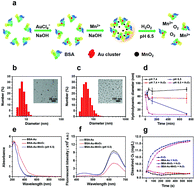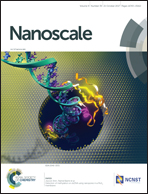Albumin-templated biomineralizing growth of composite nanoparticles as smart nano-theranostics for enhanced radiotherapy of tumors†
Abstract
Hypoxia and a dense extracellular matrix within the tumor microenvironment can often lead to the resistance of tumors to radiotherapy. Herein, we use bovine serum albumin (BSA) as a template to induce the growth of both gold (Au) nanoclusters and manganese dioxide (MnO2) via biomineralization. In the obtained BSA-Au-MnO2 composite nanoparticles, Au nanoclusters embedded within BSA not only show strong red fluorescence to facilitate imaging, but also act as a radio-sensitizer by absorbing and depositing X-ray energy within tumors to enhance radiotherapy. Meanwhile, the MnO2 core, which enables the formation of composite nanoparticles by connecting multiple albumins together, is able to modulate the tumor hypoxia by triggering the decomposition of tumor endogenous H2O2 into oxygen, so as to reverse the hypoxia-associated radiation resistance of tumors. Notably, such BSA-Au-MnO2 composite nanoparticles with larger sizes show prolonged blood circulation and increased tumor accumulation compared to BSA-Au complexes, and would dissociate back into individual BSA-Au complexes once inside the tumor with reduced pH to allow deep interstitial diffusion. As a result, highly effective radiotherapy of tumors is realized with these nanoparticles in a mouse tumor model. Our work thus presents a convenient biomineralization approach to fabricate intelligent multifunctional nanoparticles composed of biocompatible/biodegradable components for enhanced cancer therapy.



 Please wait while we load your content...
Please wait while we load your content...